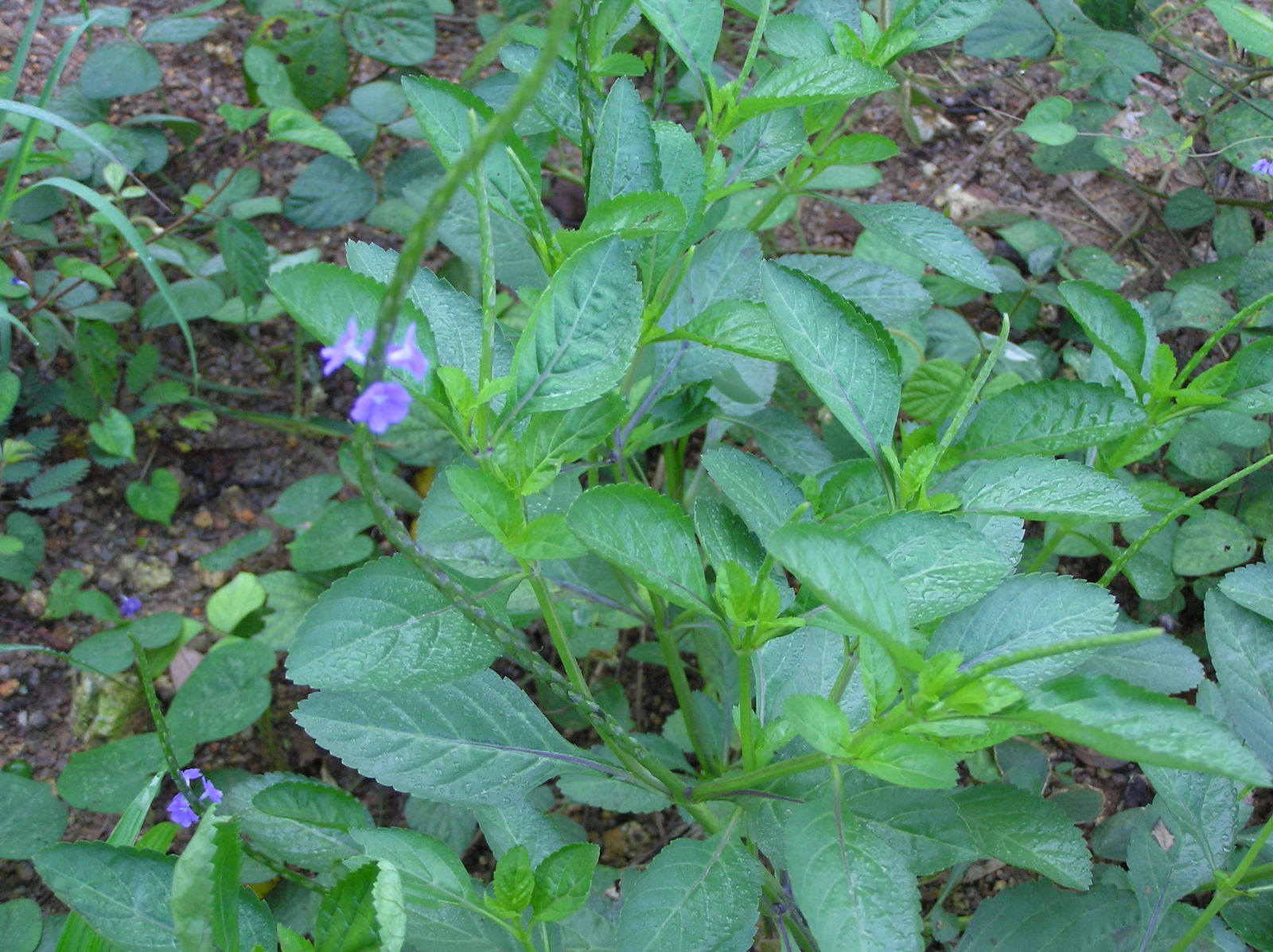|
Stachytarpheta jamaicensis
Common Names: Brazilian tea, Gervao, Rooter comb,
Verbena cimarrona, Blue porter weed, Blue snakeweed, Jamaican vervain,
Worryvine
Local Names: Iru Alangba, Agogo Igu,Iru Eku (Yoruba, Nigeria); Wutsiyar
Bera, Tsarkiyar Kusu, Wutsiyar Kasa, Wutsiyar kadangare (Hausa, Nigeria)
Species ID: NMP-250 | wfo-0000314894 | NCBI_Taxonomy ID:
634377
Scientific
Classification
Kingdom: Plantae
Clade: Tracheophytes
Clade: Angiosperms
Clade: Eudicots
Clade: Asterids
Order: Lamiales
Family: Verbenaceae
Genus: Stachytarpheta
Species: S. jamaicensis
Synonyms: Verbena jamaicensis L.; Stachytarpheta bogoriensis Zoll.
& Moritzi; Stachytarpheta pilosiuscula Kunth; Valerianoides jamaicense (L.)
Kuntze; Zappania jamaicensis (L.) Lam.
Morphological Description
- Stems: Quadrangular, green to purplish, pubescent when
young, becoming woody at base; often branched (Burkill, 1995).
- Leaves: Opposite, oblong-elliptic to ovate (2–9 cm × 1–4
cm), dark green, glossy, coarsely crenate-serrate margins (Fern, 2024).
- Flowers: Tubular blue to purple, 4–6 mm long, borne in
slender terminal spikes 10–30 cm; corolla 5-lobed, attractive to
butterflies and hummingbirds (Prance & Jongkind, 2015).
- Fruit: Schizocarp, 3–5 mm, green-turning dark brown,
splitting into two nutlets; seeds dispersed by animals or gravity (Liew
& Yong, 2016).
- Geographic Range: Native to Caribbean (including Florida); now
naturalised across West Africa (Nigeria, Ghana), Southeast Asia (India,
Malaysia), Australia, Oceania. (Kew Science, n.d.)
- Habitat: Roadsides, waste grounds, disturbed terrain;
prefers well-drained sandy/loamy soils (pH ~5.5–7.0), annual rainfall
800–2,000 mm; occurs from sea‐level to ~1,500 m (Fern, 2024).
- Ecological Role: Ruderal species in disturbed areas; supports
pollinators; may form dense stands and outcompete natives (Burkill, 1995).
- Antidiabetic: In Nigeria, leaf decoctions used for diabetes.
- Antimicrobial: Ethyl acetate root extracts inhibited
Staphylococcus aureus and Escherichia coli (MIC ~50–100 µg/mL) in Ghana;
flavonoids luvangetin and xanthyletin implicated (Utami et al., 2022).
- Anti-inflammatory / Analgesic: Ethanolic leaf extracts (150 mg/kg) inhibited
acetic acid-induced writhing by ~60% in mice, comparable to diclofenac;
verbascoside identified as one active constituent (Sulaiman et al., 2009).
- Wound-healing: In diabetic rats (Philippines) hydroalcoholic
leaf extracts accelerated wound closure (by ~70%) and increased
epithelialization; tannins and flavonoids attributed (Pandian et al.,
2013).
- Antioxidant: Methanol leaf extracts gave strong DPPH
scavenging, high phenolic content (~82.14 mg GAE/g), reduced ROS in
biochemical systems (Osukoya et al., 2016).
- Hypotensive: Aqueous leaf infusions lowered blood pressure in
rabbits; iridoid ipolamiide implicated (DeFilipps et al., 2004).
- Antimalarial: Whole-plant decoctions used in Cameroon;
ethanolic leaf extracts suppressed Plasmodium berghei parasitaemia in vivo
(Okokon et al., 2008).
⚠ Toxicity Profile: Aqueous leaf extracts had LD₅₀ > 4,000 mg/kg
in rats, with no acute mortality. However, sub-chronic dosing at ~400 mg/kg for
28 days caused mild systemic changes (liver congestion, fatty changes in
liver/kidneys/testes); intraperitoneal very high doses caused motor activity
reduction, ataxia, sedation, and drop in body temperature (~8.4 °C) – risk of
apnea/death. Pregnancy use contraindicated; children use not established. (Idu
et al., 2007; Ataman et al., 2006)
- Ornamental: Cultivated for its bright blue-purple flowers in
Nigeria and other tropical regions; used in hedges and landscaping (Fern,
2024).
- Pesticidal / Larvicidal: Leaf extracts repel Culex quinquefasciatus larvae
in mosquito control studies (Nazar et al., 2009).
- Cultural: In Yoruba usage, leaf infusions are used in
rituals for spiritual cleansing and health (Burkill, 1995).
- Ecological: Stabilises soils in disturbed areas; may become
invasive in plantations and out-compete coconut and other crops (Fern,
2024).
- Ataman, J. E., Idu, M.,
Odia, E. A., Omogbai, E. K. I., Amaechina, F., Akhigbe, A. O., & Ebite, L.
E. (2006). Histopathologic effects of Stachytarpheta jamaicensis (L.) Vahl on
Wistar rats. Pakistan Journal of Biological Sciences, 9(3), 477-482.
- Burkill, H. M.
(1995). The useful plants of West Tropical Africa (Vol. 3). Royal Botanic Gardens, Kew.
- DeFilipps, R. A., Maina,
S. L., & Crepin, J. (2004). Medicinal plants of the Guianas. Smithsonian
Institution.
- Fern, K. (2024).
Stachytarpheta jamaicensis. Useful Tropical Plants Database. Retrieved from
https://tropical.theferns.info/viewtropical.php?id=Stachytarpheta+jamaicensis
- Idu, M., Omogbai, E. K.
I., Aghimien, G. E., Amaechina, F., Timothy, O., & Omonigho, S. E. (2007).
Preliminary phytochemistry, antimicrobial properties and acute toxicity of
Stachytarpheta jamaicensis (L.) Vahl leaves. Trends in Medical
Research, 2(4), 193-198.
- Kew Science. (n.d.).
Stachytarpheta jamaicensis (L.) Vahl. Plants of the World
Online. Retrieved from
https://powo.science.kew.org/taxon/urn:lsid:ipni.org:names:1092351-2
- Liew, P. M., & Yong,
Y. K. (2016). Stachytarpheta jamaicensis (L.) Vahl: From traditional usage to
pharmacological evidence. Evidence-Based Complementary and Alternative
Medicine, 2016, 7842340.
- Nazar, S., Ravikumar,
S., Williams, G. P., Ali, M. S., & Suganthi, P. (2009). Screening of Indian
coastal plant extracts for larvicidal activity of Culex quinquefasciatus. Indian Journal of
Science and Technology,
2(3), 24-27.
- Okokon, J. E., Ettebong,
E., & Antia, B. S. (2008). In-vivo antimalarial activity of ethanolic leaf
extract of Stachytarpheta cayennensis. Indian Journal of
Pharmacology, 40(3), 111-113.
- Pandian, C., Srinivasan,
A., & Pelapolu, I. C. (2013). Evaluation of wound healing activity of
hydroalcoholic extract of leaves of Stachytarpheta jamaicensis in
streptozotocin-induced diabetic rats. Der Pharmacia Lettre, 5(2), 193-200.
- Sulaiman, M. R.,
Zakaria, Z. A., Chiong, H. S., Lai, S. K., Israf, D. A., & Azam Shah, T. M.
(2009). Antinociceptive and anti-inflammatory effects of Stachytarpheta jamaicensis
(L.) Vahl (Verbenaceae) in experimental animal models. Medical Principles and
Practice, 18(4), 272-279.
- Utami, J. P., Diana, S.,
Arifin, R., Taufiqurrahman, I., Nugraha, K. A., Sari, M. W., & Wardana, R.
Y. (2022). Antibacterial activity of Stachytarpheta jamaicensis (L.) Vahl roots
extract on some bacteria proteins: An in-silico and in-vitro study. Journal of Pharmacy
& Pharmacognosy Research, 10(6), 1087-1102.
|
